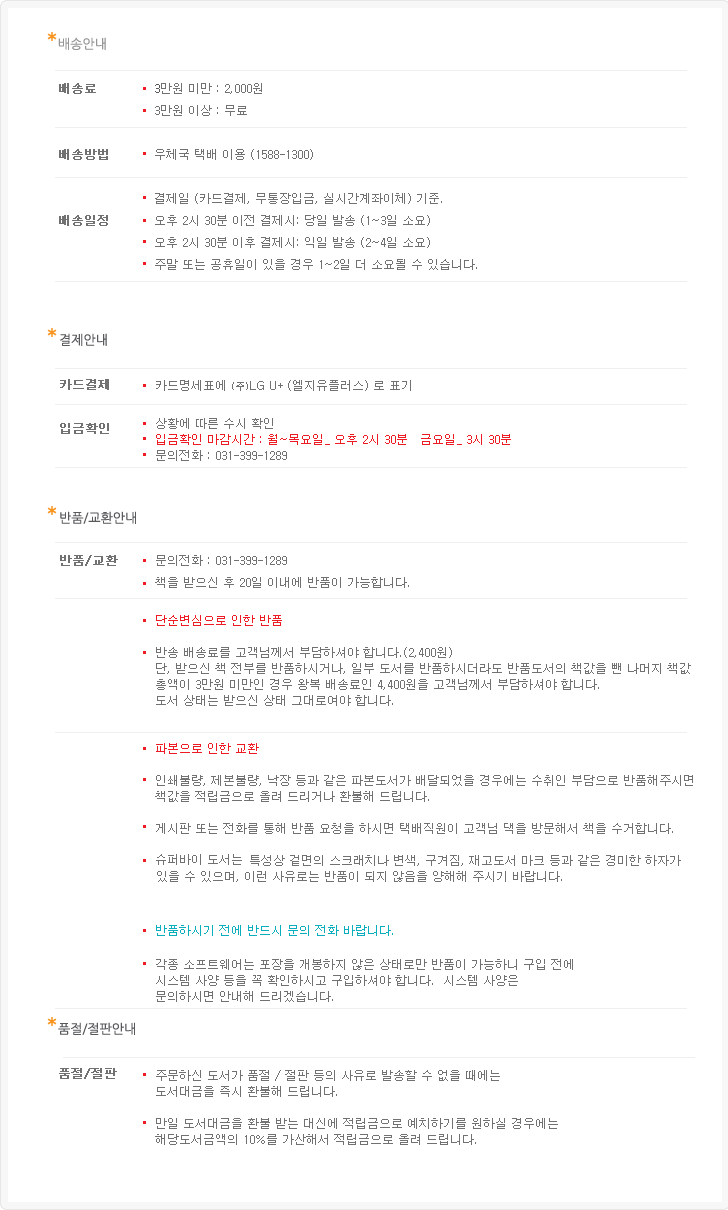|
|
|
|
|
|
|

| 최근 이 책을 구매하신 다른 회원의 책장 |
|
 |
|
|
|
[ 책 소개 ]
Harper Collins의 Let's-Read-and-Find-Out Science시리즈는 과학의 기본개념을 알기 쉽게 소개하며 어린 아이들의 과학, 기술, 자연에 관한 다양한 호기심과 궁금증을 해결해 줄 수 있는 우수한 어린이 과학도서입니다.
징그러운 지렁이들은 알고 보면 인간에게 많은 도움을 주는 이로운 동물입니다. 하루 종일 열심히 땅 속을 파고 다니면서 식물들이 뿌리를 내리고 자라는데 도움을 주며 지렁이의 배설물은 식물들에게는 값진 비료 역할을 해 줍니다. 징그럽다는 이유로 거들떠 보지 않는 지렁이들의 소중한 가치와 이들의 생태를 자세히 배울 수 있는 책입니다.
[ 서지 정보 ]
Edition: Paperback: 32 pages
ISBN: 0064451992
책 크기: 25cm x 20cm
[ 영문 서평 ]
Book Description
Crawling through the dirt, worms are hard at work, helping plants to grow. Worms help the fruit and vegetables we eat by loosening the soil and feeding the plants. Read and find out about these wiggling wonders!
Children's Literature
Here is the scoop on nature's underground gardeners! Without legs, a backbone, or teeth, worms create tunnels in dirt allowing roots and water to move through soil more easily. They perform this essential function through their normal life processes of eating and digesting the soil and plant parts that go through their gizzards and crops. That is how worms produce castings, rich fertilizer to help plants grow. Worms also cover the entrance to their holes with castings (called middens). Moving on bristles lining the underside of their bodies and breathing air through their moist skin, each worm is both male and female (but still needs a mate). After mating, worms grow a cocoon ring around their bodies. When the ring slips off, fertilized eggs are inside. After about three weeks, three to four wormlets hatch out of about 30 eggs. In six weeks, they will be adults. Worms stay underground during the freezing winter and come back out in spring. The last two pages of this book suggest activities for children to observe worms and the work they do. This basic book with simple illustrations is packed with information and is a great classroom or library text. Other titles in the 2nd stage of the "Let's-Read-And-Find-Out Science" series include Ant Cities, Chirping Crickets, and Spinning Spiders. 2004, HarperCollins, Ages 5 to 9. - Chris Gill
School Library Journal
This is a great book marred by a few unclear pictures. The well-organized text explains how worms improve the quality of soil and covers the basics about the animal's body structure, movement, diet, and reproduction. The writing is clear and engaging; in one instance, Pfeffer compares the segments on a worm's body to "the coils on a Slinky toy." Although the collage artwork is visually appealing, some of the images are a bit confusing. In one illustration accompanying the explanation of how a worm tunnels, the creature looks as if it has been chopped in two or torn up. In another, it looks as if it is decomposing. The book ends with suggestions for examining a worm in the field and a science-fair-type project using castings. Better choices include Kevin Holmes's Earthworms (Bridgestone, 1998), Michael Elsohn Ross's Wormology (Carolrhoda, 1996), and Bobbie Kalman's Squirmy Wormy Composters.
Kirkus Reviews
Here's an eye-opener for anyone unimpressed by the lowly worm. Pfeffer confirms what most preschoolers know: worms rock! In simple, precise prose, she describes how worms tunnel through soil by eating it, and how both the tunnels and the castings that the worms leave behind help plants grow in the soil. She covers worm anatomy and physiology in some detail (and, in the back, invites children to find worms and let them crawl down their arms, to experience their motion and bristles themselves). Jenkins's collages provide interesting texture; the cut-away views of worms underground are especially good. For a creature with "no eyes, no nose, no ears, and hardly any brain at all," the worm commands respect; Pfeffer shows why. Even squeamish kids will love this. |
|
|
|
|
 |
제품상제정보 배송/반품/교환 안내 |
|
|
|
Super Buy 도서는 미국 출판사의 재고도서(Remainder Book), 초과출간도서(Excess Inventory), 할인도서(Bargain Books)
등을 직수입해서 정가의 55%~80%를 할인한 가격에 판매하는 제품입니다.
Super Buy 책의 품질은 거의 새 책과 같은
수준이지만, 간혹 커버의 스크래치나 접힘과 같은 하자나, 책 하단의 재고도서 마크가 있을 수 있습니다.
저렴하게 판매하는 Super Buy 제품의 특성상 반품이 되지 않습니다만, 파본인 경우에는 착불로 반품하시면 책값을
환불해드리거나 적립금으로 올려드립니다. (반품 전에 연락 요망)
하프프라이스북에서는 중고도서(second hand book)를 취급하지 않습니다.
|
|
|
 - 등록된 128,139건의 서평이 있습니다. - 등록된 128,139건의 서평이 있습니다.
| 더보기 
|
|
|
|
|
|
|
 |
|
|
|
|
|
|